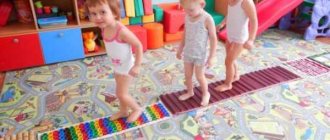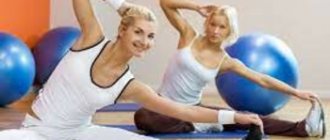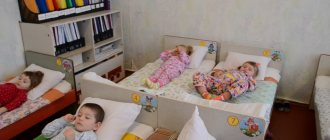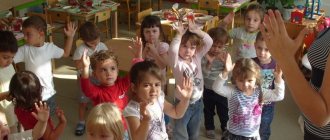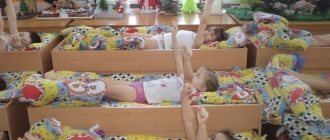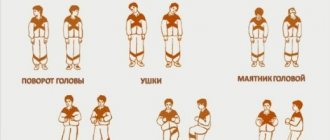Kindergarten teachers are amazing people. How many tricks do you need to know in order to take care of and protect, feed and clothe, occupy and develop boys and girls all day long, and even so that they are friendly, cheerful, and healthy! Special sets of gymnastic exercises help each child maintain a healthy mind in a healthy body.
A preschooler's day is divided in half by naps, and waking up becomes a transitional moment on which the child's mood will depend for the rest of the day. That is why gymnastics after sleep is carried out in kindergarten every day. Short in duration, almost imperceptible for the children themselves, it smoothly and carefully helps them fill with vigor and strength.
Types of gymnastics after sleep
In the methodological developments proposed by experts, the following types of gymnastics after sleep can be distinguished:
- exercises in bed with elements of self-massage;
- play gymnastics;
- gymnastics with exercise equipment and sports equipment;
- walking or jogging on massage mats/paths.
When preparing the exercise, you can use any exercise equipment that is available in the kindergarten
. As can be seen from the list, daytime gymnastics becomes a powerful set of health procedures, competently and concisely structured in time, and most importantly, interesting and enjoyable for the child.
All exercises are carried out in stages, with a gradual increase in load, and are of a playful nature. They are aimed at general strengthening of the body, prevention of disorders of posture, vision and flat feet. Psychologically, gymnastics classes unite children in a group and help them get out of the state of internal stiffness into which, as if in a capsule, the baby is immersed during sleep.
The teacher is free to choose specific exercises. He independently assesses the capabilities and needs of his students, observes which exercises are especially loved by children and, if desired, varies the tasks so as not to turn the magic of the five-minute sports session into a routine.
Gymnastics card index
It is very important to do gymnastics with your child in a playful way. The plots should be familiar and interesting to the child, and the movements should be feasible and understandable. The set of exercises needs to be changed periodically so that the baby does not get bored.
To help educators and parents, card files of exercises are posted on the Internet, for example, “File card of gymnastics after sleep,” “File card of breathing exercises,” etc. Such collections contain many sets of simple exercises with a funny plot, often in verse. The tasks are accompanied by a methodology for performing them, and the age for which the complex is designed is indicated. All exercises are selected so that they are suitable for any more or less healthy child of the appropriate age.
It will also be very useful for parents to read the book “Morning exercises in kindergarten” (author T.E. Kharchenko), which describes many developmental complexes for children two to three years old. There are also developments for gymnastics after sleep, breathing and finger exercises, exercises for developing fine motor skills of the hands. All classes are equipped with an interesting plot and recommendations for implementation. Finding a book on the Internet is not difficult.
Elements of gymnastics after sleep
Gymnastics after sleep is like a multi-colored mosaic that can be reassembled every day, creating a new image from its main elements. Daytime gymnastics, as an option, may include:
- stretching;
- breathing exercises;
- swing your arms;
- stroking biologically active zones;
- jumping;
- squats;
- simple elements of yoga;
- finger gymnastics;
- gymnastics for the eyes;
- visual-acoustic exercises.
Despite the fact that gymnastics after sleep is usually short-lived, the teacher can combine individual elements and use the developments he likes in fragments.
Video example of morning exercises:
Organization of gymnastics
All manipulations carried out with children must be carefully considered and comply with the Federal State Educational Standard (FSES) (federal state educational standards). This is a set of clear rules and requirements for education at a certain level. For the physical development of preschool children, there is a “Program for the training and education of preschool children,” which reflects the rules for conducting exercises for various groups, taking into account the age, physical and psychological development of children.
When organizing gymnastics, the teacher is guided by the following criteria:
- age;
- physical abilities of children;
- load distribution;
- complexity of exercises;
- duration;
- location.
Age
Taking into account this indicator, the set of exercises after lunch sleep differs. So, for younger children, exercises are carried out in a playful way, and the kids pretend to be birds, animals, and mother’s helpers. In this case, the teacher must complete each of the “exercises.”
In the preparatory group, children aged 5–6 years are more organized and independent, so the teacher can appoint the “eldest” child who will show the exercises to the whole group, and the rest of the children will repeat them. At this time, the teacher can devote time to individual work with specific children.
In the preparatory group, children remember the exercises performed daily, so they often practice doing warm-ups on their own.
Load distribution
A standard set of exercises is performed for 15–20 minutes. The distribution of the load is affected by curvature of posture, flat feet and other physiological problems. If there are none, the general scheme looks like this:
| Stage number | What to do | Description of the exercise | Duration (min.) |
| 1 | Arm and leg stretches | Performed in bed, immediately after waking up. You can continue the exercise in the form of alternate swings of arms and legs near the bed | 3 |
| 2 | Walking | The transition to the active phase continues with walking, from slow to gradually accelerating. You can start in a cool room | 3 |
| 3 | Active body movements | Movements to prevent problems of the musculoskeletal system are continued in a warm room. This can be active swings, bending, body turns, jumping, squats. It is recommended to supplement with sports equipment (skipping ropes, children's weights and dumbbells, etc.) | 5–7 |
| 4 | Breathing exercises | In a moderately cool room, exercise elements taken from breathing exercises | 3–4 |
Exercises for different groups
Gymnastics after sleep in the younger group
Daytime sleep is longest in the younger group of kindergarten. It can be difficult for kids to wake up in a good mood. If they were in a deep sleep, they may not immediately realize where they are. Children cry, are capricious, refuse to get up, wash, or get dressed. Therefore, during the exercises, the emphasis is on the emotional component of gymnastics: the correct selection of music, speech accompaniment, harmonization of the general atmosphere of the lesson. The images that the teacher will create during the exercises should be attractive.
Set of exercises “Sunshine”
A ray of sunshine woke up in the sky, A ray of sunshine reached out to the window.
There, outside the window, twenty children lie together in cozy beds. (Children stretch while lying in bed)
Hey, wake up, girls, boys!
You need to wear a dress and pants! Where are your pens? (Raise their hands and shake them in turn)
Where are your legs?
(Raise their legs, take turns doing swings)
Now we’ll play with you a little!
Come on, imagine that summer has come: The city has woken up, Rubbing their eyes with their fists).
And the sun rose.
(Raise their arms above their heads and stretch).
That is great!
So, let's ride into the distance along the path on a bicycle! (Doing the “Bicycle” exercise)
We drove and drove... - We arrived at the mill!
(Doing the “Mill” exercise)
Then we went. We drove, we drove... - We arrived at the river.
Let's help your feet, Let's touch some water! (They get up from the cribs, lowering their legs one by one to the floor)
Ay, the water is cold!
Here is one leg... (They jump on the right leg)
But here is another leg, what a nimble one!
(They jump on their left leg)
We stood in the water, Swimmed, (I make movements with my hands imitating swimming) We dived... Oh, good!
(They do squats with their arms extended forward)
They stood up from heel to toe and walked out onto the sand together.
(On tiptoes they walk out of the bedroom into the common room, where massage mats have already been prepared)
They walked on sand - They stepped on pebbles.
Oh, it's hot! (They walk in place on rubber mats for 2 minutes)
And now we have risen,
(Converge in the center of the hall)
We hold hands together.
(Form a circle)
Stretched,
(Stretched),
Smiled.
(Smile at each other).
Finally we woke up!
Gymnastics after sleep in the middle group
Gymnastics for middle group students should include a larger number of exercises. It is aimed not only at the emotional unity of children, but also at the comprehensive improvement of the child’s body. Elements of breathing exercises are required. It is advisable to combine gaming techniques with a set of exercises to prevent visual impairment and posture.
Meaning and benefits
Each child is individual, and if one easily wakes up after a lunchtime nap, for another it can become a real challenge. Therefore, in many kindergartens, teachers use a gymnastics complex that helps children quickly return to active mode. The main goal of such activities is to get the child accustomed to the skills of doing exercises, which in the future will form the habit of daily healthy exercises.
To make it easier for the student to accept new things, gymnastics is carried out in a group of children. When other children are nearby with the child, it is easier for him to understand the essence of the tasks, and if something turns out to be incomprehensible, you can always learn from the example of friends. In addition to building team spirit, exercise is very beneficial for health, as it affects all systems of the body:
- increases immunity;
- builds resistance to stressful situations;
- stimulates the nervous and respiratory systems;
- accelerates metabolic processes;
- accelerates blood circulation;
- optimizes the functioning of the cardiovascular system;
- trains muscles, toning them;
- prevents the appearance of flat feet and curvature of posture;
- develops fine motor skills and coordination of movements;
- increases cognitive abilities;
- improves mood.
Attention! Exercising after a nap should be done an hour before meals or some time after meals. A ventilated room without drafts should be chosen as a location.
Sleep plays a big role in a baby's life. One of its main tasks is to restore strength from the past day and give energy for the future. The process of waking up after daytime and nighttime sleep is no less important. Most children wake up in a bad mood, and some little ones cannot be woken up at all. This makes life difficult for young parents, since babies can be in no mood throughout the day. To prevent this from happening, you can regularly introduce a healthy set of home exercises into your awakening ritual. You can do gymnastics with your baby without getting out of bed.
Many kindergartens have been practicing children's gymnastics after sleep for several years. It helps babies wake up easier, gives them energy and helps them spend the day more comfortably. Some exercises can be done at home. It is important to exercise in a positive and playful manner so that it is enjoyable for you and your baby.
Little children grow quickly, so it is important to start light physical activity at an early age. In order to grow healthy they will need a lot of strength and energy. Children who are hardened from an early age rarely get sick, and they are also characterized by healthy activity and curiosity. Such kids love to communicate with peers and easily make contact with people.
Gymnastics after a nap develops well:
- vision;
- speech;
- memory;
- endurance;
- patience.
Invigorating gymnastics after sleep helps to cope with waking up easier. Before starting a set of exercises, it is important to prepare your baby’s bedroom:
- ventilate the room;
- let light into the room;
- remove everything unnecessary from the bed and floor so that it does not restrict movement;
- prepare the music;
- if classes are held with additional paraphernalia, it must be prepared in advance. (ball, jump rope, hoop, massage blanket).
You can start doing the exercises right in bed, after the child has opened his eyes. It is important to gradually increase the pace, not to rush:
- Slow awakening . At first, turn on the music quietly, and as you wake up, you can increase the volume. For a more positive mood, choose music that your baby likes, even if it is not too rhythmic. Let the light into the bedroom, open the curtains. Take the blanket off the baby and run your hands over the baby's entire body, starting from the shoulders and ending with the heels. You can give a light massage to your feet and palms.
- Warm up . The simplest thing to start with is stretching. Let your baby stretch several times. Next, you can show your baby an exercise with lifting arms and legs in turn, and also carefully perform circular movements with the neck. Do breathing exercises with your child: inhale and exhale deeply several times. After the child finally wakes up, you can move on to more serious exercises where you need the baby to stand.
- Easy game exercises . Before starting charging, it is recommended to ventilate the bedroom where the baby sleeps. This is done so that you can combine the process of gymnastics with light hardening. Light exercise includes the following set of exercises: get up and walk on your toes, then on your heels, raise your knees high, roll from heel to toe and back, you can make small circular movements with your hands starting from the shoulders, slow bends from side to side, and also back and forth. Then the load can be gradually increased.
As soon as your baby starts doing gymnastics after sleep, the positive effect will not be long in coming. Waking up will not be as difficult for the baby as it was before. In order for the classes to be effective, it is enough to perform the exercises 3-4 times, alternating the load with rest. Then the baby’s muscles will always be in good shape. It is important to ensure that the child’s breathing is uniform and calm during exercises.
The main purpose of the exercises after waking up is that the child, by performing them, moves more easily from a sleepy state to wakefulness.
Exercising after sleep has the following positive effects:
- improves mood;
- increases the child’s perseverance;
- prevents various diseases (scoliosis and flat feet);
- strengthens the respiratory tract system;
- improves the nervous system (makes it more resilient);
- makes the child's immunity strong;
- From childhood, a child begins to lead a healthy lifestyle, starting his day with exercise.
Gymnastics after night and daytime sleep does not make any fundamental difference. The only thing that needs to be adjusted is the time. After waking up at night, you should not study for more than 15 minutes. But after a nap, you can do gymnastics for about half an hour. It is necessary to monitor the child’s condition; the set of exercises should not be tiring. It is important that he finds it interesting and fun. Otherwise, the baby may get bored and subsequently lose interest. To prevent this from happening, monitor your baby’s condition and adjust the time based on his mood. After just a few days of practice, you will know exactly what your child likes.
There are different sets of exercises for each age group. What is suitable for a 2-year-old child will no longer be entirely relevant for a child who is 3 years old or more. Therefore, when choosing exercises, it is important to look at the child’s physical fitness and take into account age restrictions.
Children of school and preschool age can perform more complex physical exercises:
- Cat . The child gets on all fours and bends his back down and back up. The back takes the shape of a wheel.
- Kolobok . The baby lies on his back, tucks his knees to his stomach, wraps his arms around his legs and rolls back and forth, working his abdominal muscles.
- Bike . One of the most popular exercises. It is often done not only by children, but also by adults. The exercise is performed while lying on your back. The child raises his legs and begins to make circular movements, imitating riding a bicycle.
If you do gymnastics, follow all the rules, but the child still wakes up cranky, out of mood, or doesn’t want to get up at all. It is worth paying attention to the rhythm of the baby's day. How long does he stay awake, does the baby sleep enough for his age, is there time in his daily routine for relaxation before bed? Certified children's sleep consultant Tatyana Kremneva will help you understand these and many other questions regarding children's sleep. Come to the “Baby’s Dream” Instagram page, read posts, watch live broadcasts.
Children who exercise after sleep are less likely to get sick or tolerate various diseases much easier. Before you start practicing home gymnastics, you can consult your pediatrician about contraindications.
Author: Tatyana Kremneva.
Breathing exercises
An important part of awakening is correct breathing, which can be achieved using a number of special manipulations:
- clicking his tongue, parodying horses;
- active giggling;
- inflating a ball: a deep breath is followed by a uniform release of air, while children spread their arms to the sides, imitating inflating a ball; finish the exercise with a clap as a sign of the bursting of the balloon;
- dragon: active inhalations through the nose and exhalations through the mouth;
- snake: attempts to touch the tip of the nose and chin with the tongue;
- cow: exhalations should be smooth, measured, accompanied by a drawn-out “moo-oo”;
- steam locomotive: with their arms bent at the elbows, children walk one after another around the room (cars), while saying “chuh-chuh-chuh.”
All these exercises are aimed at strengthening and stimulating the respiratory tract, ensuring ventilation of the lungs.
